One of the common reader requests I get is for “toxic” ingredient breakdowns, so today I’m looking at two ingredients that are commonly on “avoid” lists: propylene and butylene glycol.
What are propylene and butylene glycol?
Glycols in chemistry are ingredients that contain two OH (alcohol) groups. Propylene glycol contains 3 carbon atoms, while butylene glycol is a little larger and contains 4 carbon atoms. In glycols, the alcohol groups are attached to different carbons.
Confusingly, the names “propylene glycol” and “butylene glycol” can refer to several slightly different substances, since there are a few choices of carbon atoms for the OH groups to be attached to.
Propylene glycol usually refers to propane-1,2-diol (formerly known as 1,2-propanediol). The less commonly used propane-1,3-diol is also sometimes called propylene glycol, but usually in cosmetics it’s called “propanediol”. Propanediol is become more popular since propylene glycol’s been on all these watchlists.
It’s a similar story for butylene glycol. “Butylene glycol ” usually means butane-1,3-diol, but sometimes it’s also used to refer to the related butane-2,3-diol.
What do propylene and butylene glycol do in products?
Alcohol (OH) groups on ingredients usually make them good humectant moisturisers that can hold onto water and keep your skin or hair hydrated. For example, glycerin has almost the same structure as propylene glycol, but with an additional alcohol group. Propylene and butylene glycol are both humectant moisturisers.
Propylene and butylene glycol are also commonly used in products as solvents. They’re good at dissolving ingredients that aren’t very water-soluble. This means you end up with a more effective product since dissolved ingredients can spread out on your skin better and penetrate. Additionally, they can have antimicrobial effects and boost the effectiveness of preservatives.
Propylene glycol is a bit more common in products than butylene glycol. Both ingredients are commonly used in a ton of products, such as serums, moisturisers, toothpaste, shampoos and cleansers. They’re often also the main ingredients (after water) in sheet masks. They have a slightly slimy, goopy feel.
You’ll also find propylene glycol used as antifreeze, and in foods (it gets metabolised into lactic acid after you eat it). A few skin conditions can also be treated with propylene glycol, including seborrheic dermatitis and ichthyosis.
What’s wrong with propylene and butylene glycol?
There are a whole bunch of reasons why people tell you to avoid propylene and butylene glycol – let’s take a look at them.
“They’re petroleum-derived”
The word “petroleum” is pretty scary for most people, since it makes you think of oil spills and toxic waste. But a lot of non-scary chemicals can be derived from petroleum too – for example, almost all plastics are made from petroleum. Where something comes from doesn’t tell you much about its toxicity.
Related post: Video: Are Natural Beauty Products Better?
“They’re used as anti-freeze”
An anti-freeze is a substance that decreases the freezing point of water. The “scary” anti-freeze that causes poisoning is ethylene glycol, which is much like propylene and butylene glycol, but with only 2 carbons.
The three substances are similar in lots of ways, since they all have two OH groups: they’re all colourless liquids and work well as solvents, and they all work as anti-freezes. But a slightly longer or shorter carbon chain can make a big difference in terms of toxicity. 10 mL of ethanol (e.g. in the form of a shot of tequila) is quite fun and enjoyable for most people, but if you take off a carbon you get methanol, which is super toxic – 10 mL can make you go blind.
Same deal with the glycols – ethylene glycol is far more toxic than propylene and butylene glycol.
“They’re so dangerous workers need lots of protection to handle them”
A few places warn that workers need to wear special equipment when handling these chemicals. These warnings come from the MSDS (material safety data sheets), which list the precautions for handling the raw material. But these warnings need to capture the worst case scenarios, and are for very large, highly concentrated amounts of the substance.
The MSDS information sounds scary even for otherwise safe substances. For example, sodium chloride (table salt) gets scary phrases like:
- A self contained breathing apparatus should be used to avoid inhalation of the product
- May affect behavior (muscle spasticity/contraction, somnolence), sense organs, metabolism, and cardiovascular system.
- May cause adverse reproductive effects and birth defects in animals, particularly rats and mice (fetotoxicity, abortion, musculoskeletal abnormalities, and maternal effects (effects on ovaries, fallopian tubes)
Related post: What’s wrong with SLS?
“They can corrode stainless steel containers – imagine what they do to your face!”
The MSDS also says that the glycols can corrode steel containers, which has led some people to say that “if they can corrode steel, imagine what they can do to your skin!” Luckily our skin isn’t steel… since water also corrodes steel.
“They’re penetration enhancers”
Since propylene and butylene glycol are penetration enhancers that can help other ingredients enter your skin, many “toxic ingredient” lists say that they’ll increase penetration of other toxic ingredients into the bloodstream. This is technically true, but:
- this means they’ll also help actives that you want in your skin penetrate, and
- a lot of really unexciting things are also penetration enhancers, like water on your skin from cleansing.
Related post: All About Cleansing & How to Choose a Gentle Cleanser
“They can cause irritating and allergic reactions”
Here’s the actual legitimate issue with propylene and butylene glycol: in high concentrations, they can be irritating, and very rarely they can cause allergic reactions.
The Cosmetic Ingredient Review, who investigate cosmetic ingredients, have found that both propylene glycol and butylene glycol are safe when used in products that are designed to be non-irritating – in general, this means that propylene glycol can be used in products at up to 50% concentration (although most products will contain less than 20%), while butylene glycol can be used pure without many problems.
Propylene glycol is a bit more irritating than butylene glycol. Unsurprisingly, irritation with propylene glycol has been found to be worse when the product’s applied and then covered, and on broken skin as well.
It’s also possible to have a true allergy to propylene and butylene glycol, where your immune system gets triggered by them, but it seems to be extremely rare. Being allergic to propylene glycol doesn’t necessarily mean you’ll be allergic to butylene glycol.
Related post: Should You Be Avoiding Parabens? The Science
Are propylene and butylene glycol worth worrying about?
Even the EWG, which usually is pretty scaremongery and chemophobic, only rates propylene glycol at 3 on their “danger scale” and butylene glycol at 1.
If you’re sensitive to propylene or butylene glycol, you’ll notice that products with large quantities might make your skin itchy and irritated, and you’ll want to avoid those. But otherwise, they’re very safe ingredients.
This post contains affiliate links – if you decide to click through and support Lab Muffin financially (at no extra cost to you), thank you! For more information, see Disclosure Policy.
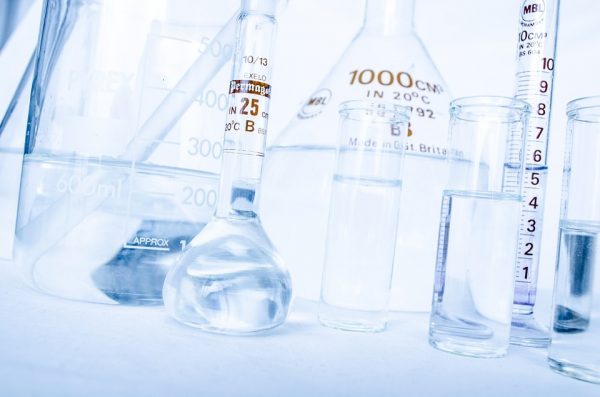
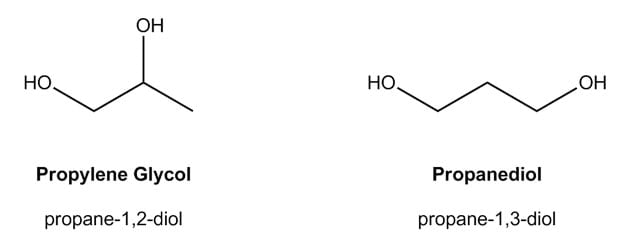
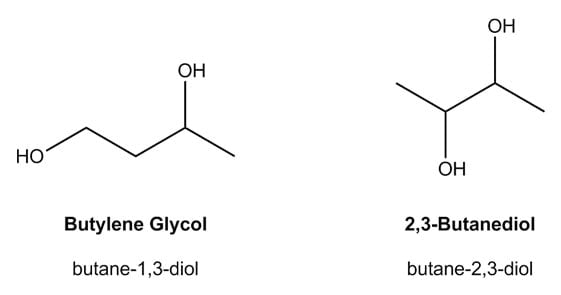

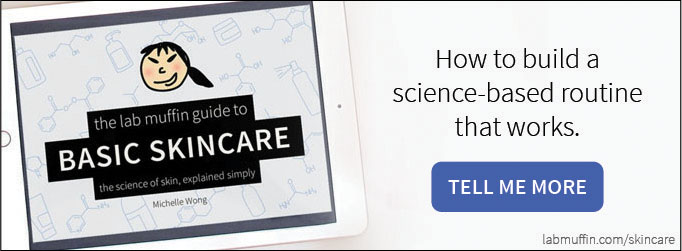
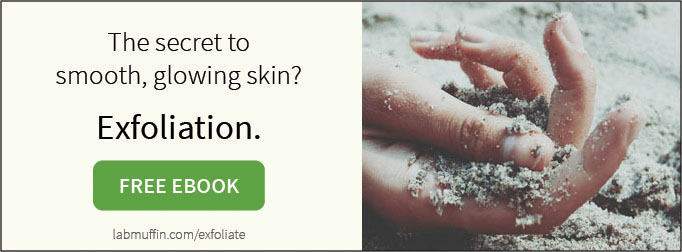
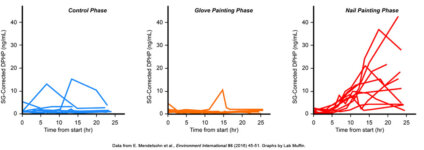
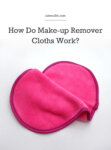
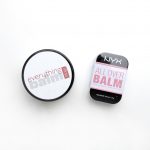

Thank you for this, as always.
It’s one of my pet peeves with one- or two-ingredient serums and oils* (particularly the overly precious sort that successfully market themselves at insultingly high price points using appeals to nature): the absence of surfactants and adjuvants and preservatives, the agents that make well-rounded skincare products stay on your face rather than pill up or slide off, that help disparate active ingredients blend together and have a sensible shelf-life post-blending, and that deliver those active ingredients where they’re actually effective.
As you say, part of the antipathy for these helpful “chemicals” is the success of scare-mongering and part of it is just straight-up scientific illiteracy posing as Boot Strapped, Contrarian Free Thinking. It’s kind of depressing. As you may have seen, Paula Begoun was briefly interviewed by The Cut last week, and while some of that conversation was frustrating to read (Paula was not picking up what the interview was laying down half the time), she made a similar point as you have, in the past, about the decline of parabens and the consequences of pointlessly demonizing them.
*which I like and I use because they have a place in my regimen, but I try not to be credulous about doing so
I don’t mind both in my regime, as I am not allergic to them, but get so many questions when I list them in a review. Thank you for this article, I´ll just link to you int the future now.
I love propylene glycol as a humectant. Where I live the pharmacy carries a very basic moisturizer containing 20% propylene glycol, and this is actually the first hand recommendation to use during acne treatments such as isotretinoin. That’s why I first started using it and have continued after treatment because it has such a plumping effect on my skin.
DAMN, drop the mike. This was such a great post! As always, thank you for your epic, educational candor. I love it. Really good information.
Thanks for this fabulous article, which was beautifully written and informative at a level I could understand without getting a headache 😆 Happy to have found your site as I slowly become better educated about skincare and fragrances. Until recently I didn’t realise how much I had absorbed the negative bias against ‘unpronounceable ingredients’, happily we are never too old to learn!
Haha, oh O-chem days. Wish more people would read this and stop saying stupid things like “ingredients you can’t pronounce” and “loaded with chemicals.”
Re: DIY setting sprays–I take the extra “juice” from sheet mask packets and mix them with rose water ($2/bottle at international markets) and a little bit of vegetable glycerin. I’d like to try high-end setting sprays but my stingy side can’t deal with paying that much for fancy water.
Thanks for the article, I really appreciated it.
Sorry for the question ages after you posted this: what is the difference between these two and pentylene glycol? I see that one all the time now.
Thank you for the article! It is a nice read!
In the text is mentioned that people can be allergic to propylene glycol while not having any reaction to butylene glycol. Could this also be the other way around, that there is a allergic reaction or a sensitivity to butylene glycol but not to propylene?
I’m not sure, but I would guess so!
I feel like Lab Muffin has become less science driven and more affiliate driven. The science part is skewed and favours affiliate products rather than telling it how it actually is. I find it really difficult to read and actually take what you say seriously anymore.
Very sad!
There are nine links in this post directed to pages outside of this blog.
Only one contains any reference to specific, named commercial products—an Amazon affiliate link to a generic search for sheet masks, with no indicatIon Michelle is endorsing or highlighting a particular brand.
Another is a wikipedia article debunking a common misunderstanding about the dangers of a bogstandard formula ingredient found in countless products made by many manufacturers.
The others are a meta analysis of pre-existing literature on another ingredient common to dermatology but with many other applications, a case study of an unusual contact reaction of a common ingredient, several double blind trials comparing different treatments, and a safety assessment of ingredients commonly used to enhance texture and improve the humectant and penetration-enhancing virtues of, again, ubiquitous ingredients that are not associated with any one brand.
Are you perhaps commenting on the wrong post??
You are specifically talking about links that you find no problems with. The person you are replying to, however, did not mention links at all. You literally decided what you were going to argue against and went with it, even though the original comment had nothing to do with what you were arguing. That’s a strawman, my friend.
I tend to agree with their comment. I was excited to find this page, only to see it showed a bias for painting all synthetically derived chemicals in a good light. The article writer Michelle skimmed over the topics that would potentially make propylene glycol and butylene glycol look back – such as how they are derived (which does matter, by the way – in much the same way that non-organic hemp will contain whatever pesticide was used on it or in the soil around it, because they are extreme bio-accumulators; so much so they were they first successful item used in soil remediation projects after Chernobyl!) Coming from organic soils and pesticide-free crops makes a huge difference in the safety of hemp products. This is but one of tons of examples I could provide that negates the claim that where something is derived from doesn’t matter. If you’re going to claim how it’s derived has no affect, than you have to show your work – not merely say it’s so.
She also didn’t explain why these supposedly completely harmless products could cause skin irritation or allergic responses. Generally speaking, how or why something causes skin irritation is something to be explored and explained, rather than glossed over.
This is just one article, and I can see an extremism towards lab chemicals that uses the tired, dismissive antics of calling anyone who disagrees “Fear-mongering”, or essentially anti-science.
As a huge advocate of the scientific method and the work of many different kinds of scientists, I also recognize the folly in assuming science can do no wrong, or believing everything to be set in stone after a few studies. Science is about learning, exploration, discovery, and trying to create the best explanations for the things we see and discover. It does not make proclamations about truth, and any good scientist worth her salt would stick to the facts, and throw their biases out the door. Even studies on make-up products and their ingredients are full of bias and agendas – who do you think does most of these studies?
All this to say, keep an open mind, and stop arguing against things people haven’t even said. That’s the way a good scientist would operate 😉
>in much the same way that non-organic hemp will contain whatever pesticide was used on it
This is incorrect – propylene glycol and butylene glycol are compounds, whereas hemp is a complex mixture. Compounds by definition are the same regardless of source. This is basic high school chemistry: https://www.bbc.co.uk/bitesize/guides/z463rwx/revision/2
Skin irritation can be caused by many otherwise harmless substances including water. Allergens are also usually harmful to a very small subset of the population and harmless to the rest – if you think about common allergens, you’ll know that most of the population tends not to have issues with them e.g. fish, peanuts.
I think the reason you seem to be perceiving an “extremism towards lab chemicals” is that appeal to nature is a very strongly rooted fallacy. I think it shows from your characterisation of nature vs science as binary opposites, when science actually encompasses the study of both natural and synthetic substances. This article might help with clearing up some of those misconceptions: https://labmuffin.com/natural-vs-chemical-which-is-better/
I think people dream sometimes . writing scientific research articles takes time, you read the information for free, do not pay a cent for it and complain that there is an affiliate link! Especially knowing how few one can earn on those links I find it so terrible how people are! What do you offer to others for free? Only your complaints? Thank you, Michelle, for your work, unbiased opinions with a real scientific background. I would ban unthankfullness and people who are so far away from reality
Jeff, my dude, if you were trying to make some kind of bullshit point about Michelle’s audacity in conducting herself EXACTLY as her subbies need her to in order to review stuff they’re trying to decide whether or not to buy, or her outrageous conduct that is EXACTLY the SAME frickin way that most every goshdamn blog online conducts business, that NO ONE ELSE seems to take issue with, well, this was a particularly dumb-ass post on which to do so.
This is an educational post on humectants, dude! Tell me, please, WHERE in this post does she slut herself for PR? I am disappointed in you, Jeff, I don’t know if I can trust your agenda..who do YOU have loyalties to?hmmm?
I suspect you’re probably having some personal issues. It happens to the best of us, but for frocks’ sake, don’t take it out on my girl..she is one of the only voices on the internet any of us can trust, & you saying she’s a sellout really only reflects badly on you, Jeff.
Muchlove, suki
Very educational and eye-opening. Thanks!
Hi,
I’m actually one of the few who’s allergic to butylene glycol (it gives me scaley rashes and flakey skin). I’ve been looking into cross related ingredients that I could also be allergic to recently and I was wondering if you could give me any insight on whether 1,3 butandiol and 1,4-butandiol were concerns to me. In general, should I be wary of butane like ingredients as well.
I’ve been testing my skin lately and I seem to be irritated to polyisobutene as well.
Any thoughts?
Polyisobutene is very very different from butylene glycol – it’s actually a polymer, so it’s much larger than butylene glycol. If you’re sensitive to both, it would be for different reasons.
1,3-butanediol and 1,4-butanediol are much more similar to butylene glycol so I think it’s more likely that you’d be sensitive to them for the same reason – you might not be sensitive to them, but I would be cautious when introducing a product that contains a lot of them.
Hi! Thanks for the great article!! I’m one of the few people who are allergic to propylene glycol. I read an article a few months back stating that propylene glycol is the number one, common allergy among atopic dermatitis (Eczema) sufferers. I just find that so interesting seeing that propylene glycol is in almost all prescribed topical creams to treat this condition.
I’m also allergic to propylene glycol and have a tough time keeping it out of my life. I appreciate your thorough explanation and have bookmarked this post for reference. So many medical practitioners don’t seem to know that this is a real allergy – I’m hoping that your article helps.
HI Michelle, what are your thoughts on petroleum derived beauty products from an environmental perspective? Not necessarily after they’ve been used in skincare/washed into water ways etc – This 2014 study noted propelene glycol had a negligible effect https://pubmed.ncbi.nlm.nih.gov/24984837/. But more from a – is it environmentally responsible to make beauty ingredients from petroleum? Are these components by-products? Does their commercial use (beauty industry and beyond) create significant profits for this polluting industry. Can they be engineered without it? (I’m obvs no biochemist!) The EWG do a great job at health implications for their skin deep ratings but don’t seem to consider the actual environmental cost of ingredient production on our environment. Do you know anyone talking about this?
Thank you 🙂
The EWG isn’t a good source – they fearmonger about ingredients based on their own system, which doesn’t match what we know about toxicology: https://labmuffin.com/clean-beauty-is-wrong-and-wont-give-us-safer-products/
Petroleum-derived cosmetics are made from byproducts, so they won’t have huge impact that way – “natural” ingredients are also dependent on fossil fuels for their production (harvesting, fertiliser production etc.), and often have a higher carbon footprint due to that, especially if they’re organic (organic farming is usually less efficient).
Your responses imply that you have a bias for unnatural products, and a bias against natural ones. Do you have references to sources that back you up, instead of just linking back to your own articles?
The article has a toxicologist explaining the basics of toxicology – you can find this in any introduction to toxicology textbook e.g. https://www.wiley.com/en-au/Toxicology+and+Risk+Assessment%3A+A+Comprehensive+Introduction%2C+2nd+Edition-p-9781119135913
Hi, do you have a source for the claim that natural ingredients often have a higher carbon footprint?
I haven’t seen anyone do an overview of all the ingredients out there (I imagine it’ll be quite difficult to try to do head to head comparisons, given different ingredient potencies and sources), but Jen of The Eco Well has mentioned a lot of examples before!
Sorry so late on this. It is probably not so much biased as it is comman sense. Farming anything in mass quantities is going to take a toll. Everyone likes to think that natural products are being grown by some adorable hippy couple in overalls on their small plot of land. Just as somehow electric cars have been the next save the planet idea. You know how much energy it takes to power batteries? Or all the batteries that aren’t in use will do to the environment?
Yes natural ingredients probably are better for the world if, you are buying your face wash from the couple in over-alls down the street and they only sell their products in a 5mile radius at a roadside stand. But if you are in Cali and the natural face wash you buy is in New Jersey and they are a big enough company for you to have heard about them and you’re ordering on the internet. Well then, you may have not added more foot prints in the sand but you sure as shit didn’t stop walking on the beach.
Thanks for this! I have some eczema/psoriasis and general skin dryness/sensitivity. I had a patch test done a few years ago and found out that I’m allergic to propylene glycol, among other things. I recently started using a new retinol serum which I just learned has butylene glycol listed as one of its first ingredients – it has been irritating my skin a bit so I’m wondering if I actually may have sensitivity to it, along with propylene glycol (which I’ve avoided since the patch test). I’m buffering for now, to see if my skin adjusts, but I’m a bit skeptical, having seen that ingredient.
I’ve been looking for a blog like this for the longest time. Thank you so much for breaking down these harsh chemicals! I’ve noticed upon shopping at major cosmetic retailers that propylene glycol and other glycols are the main ingredient in a lot of face masks and even Korean skin care products. I even noticed it in Polish skin care products. Not sure why they’re using these harsh chemicals. Is it because it’s cost effective? How about our skin?
I’ve been doing a lot of research and will continue to do more research until I find the healthiest product on the market.
Thank you Lab Muffin!